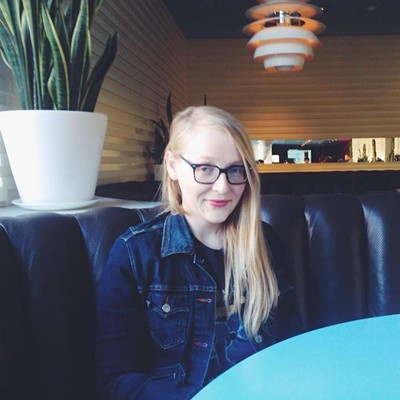Every other year, New Times puts the spotlight on Phoenix's creative forces — painters, dancers, designers, and actors. Leading up to the release of Best of Phoenix, we're taking a closer look at 100 more. Welcome to the 2016 edition of 100 Creatives. Up today is 88. Patricia Sannit.
For sculptor Patricia Sannit, days begin with a hike in the mountain preserve near her Phoenix home and end with keeping up with the business side of art.
But it's what happens in between that has made the 56-year-old artist, who works with reclaimed clay to create works influenced by archeology and human history, one of the Valley's most notable creative forces. Once her family departs for work and school, she says, "I change into work clothes, open the door to my studio, and begin. I start with clay."
The medium infuses Sannit's work with meaning. "As a result of my desire to bring a real sense of connection to history in the work, I work with reclaimed and found clay," she says. "I receive donations of clay from artists, schools, and art centers." It arrives in buckets, sometimes wet, sometimes dry; occasionally, it's a formed and finished piece that has to be soaked and broken down.
"In my thickest work, if one were to slice it open, an edge of another artist’s pot or sculpture may be found, embedded within my work," Sannit says. "I love this kind of clay, real history hidden with in it, and I love clay itself, because clay is part of our cultural history, and the transformation of clay from wet to hard represents the passage of time, process, and change, and forces a capitulation of total control."
Recently, Sannit was recognized with the 2016 Arlene and Morton Scult Contemporary Forum Award at Phoenix Art Museum. The award means a cash prize of $5,000, as well as a solo exhibition at the museum in 2017 that will bring the community into her latest body of work. And currently, she has a show with painter Christopher Jagmin on view at Mesa Contemporary Arts Museum. All of which is perfect for Sannit, whose art largely focuses on people, society, and human interaction.
"We humans share, and have always shared, common dreams, worries, impulses, and hopes," Sannit says. "I keep this truth close, and it lies at the core of my work, as does history, and how human ambition has fueled a cycle of imagination, creation, and sometimes, destruction. As such, I try in my work to reference both the grand historical movements that seem to sweep across continents and the personal objects that connect one person with their time and place."
These larger connections and stories are exactly why Sannit pursued a career in the arts to begin with. "It made me happy," she says, "and I felt like I could make a positive contribution to society."
I came to Phoenix with one husband, one baby, one dog, a studio full of art supplies, a show to put together, anticipation of a new adventure, ambition, insecurity, arrogance, apprehension/lack of comprehension about what 110 really felt like.
I make art because it is the way I am wired. I have always made art. I see the world as a systemic whole; synapses firing between ganglia of concepts, visions, and related ideas and concerns. I make visual metaphors. I can’t help it.
I'm most productive when I am surrounded by creative people and a deadline looming.
My inspiration wall is full of images of archeological sites, bog-people, random bits of metal for Davis Salvage, images of works by Eduardo Chillada, Lucius Fontana, Brancusi, Janine Antoni, Francis Alys, Noguchi’s collaboration with Martha Graham, a list of human universals by Professor of Anthropology Donald Brown, topographical maps, old army maps, images of the Fibonacci Sequence, a current view of the tree of life, encompassing the total diversity represented by sequenced genomes.
I've learned most from making, making mistakes; the artists and scientists, friends, and family who populate my world. And NPR.
Good work should always challenge preconceptions, delight with an unexpected insight, push, be intelligent, be authentic.
The Phoenix creative scene could use more opportunities for mid-career artists to exhibit, and nonprofit art centers.
The 2016 Creatives so far:
100. Nicole Olson
99. Andrew Pielage
98. Jessica Rowe
97. Danny Neumann
96. Beth Cato
95. Jessie Balli
94. Ron May
93. Leonor Aispuro
92. Sarah Waite
91. Christina "Xappa" Franco
90. Christian Adame
89. Tara Sharpe
[
{
"name": "Air - MediumRectangle - Inline Content - Mobile Display Size",
"component": "18478561",
"insertPoint": "2",
"requiredCountToDisplay": "2"
},{
"name": "Editor Picks",
"component": "16759093",
"insertPoint": "4",
"requiredCountToDisplay": "1"
},{
"name": "Inline Links",
"component": "17980324",
"insertPoint": "8th",
"startingPoint": 8,
"requiredCountToDisplay": "7",
"maxInsertions": 25
},{
"name": "Air - MediumRectangle - Combo - Inline Content",
"component": "16759092",
"insertPoint": "8th",
"startingPoint": 8,
"requiredCountToDisplay": "7",
"maxInsertions": 25
},{
"name": "Inline Links",
"component": "17980324",
"insertPoint": "8th",
"startingPoint": 12,
"requiredCountToDisplay": "11",
"maxInsertions": 24
},{
"name": "Air - Leaderboard Tower - Combo - Inline Content",
"component": "16759094",
"insertPoint": "8th",
"startingPoint": 12,
"requiredCountToDisplay": "11",
"maxInsertions": 24
}
]











